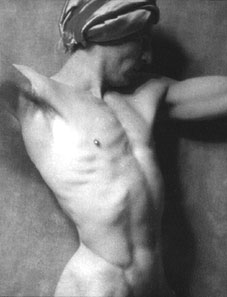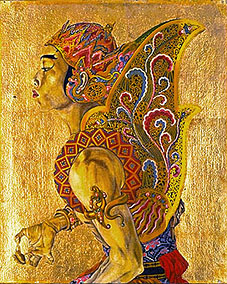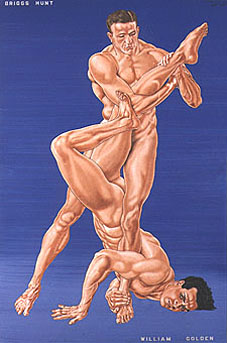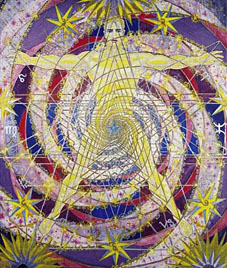
Left: Stowitts photgraphed by Nickolas Muray, 1922.
Hubert Julian Stowitts had a number of careers, including dancer, film actor, painter, designer and metaphysician. As a dancer he worked with Anna Pavlova, who discovered him in California in 1915 and took him on tour around the world. His statuesque figure was used by Rex Ingram for the infernal scenes in The Magician (1926), an adaptation of Somerset Maugham’s rather limp roman-à-clef based on the exploits of Aleister Crowley. The scene with Stowitts as a satyr owed nothing to the book, however, being more inspired by the director’s fondness for the tales of Arthur Machen. Most photos that turn up from this film show Stowitts rather than Paul Wegener who played the sinister alchemist of the title.
Stowitt’s painting developed in the 1930s and included a series of 55 paintings of nude (male) athletes for the 1936 Olympics (see Ewoud Broeksma’s contemporary equivalents at originalolympics.com). Other paintings depicted dance scenes, costume designs, people encountered during travels in the Far East and, in the 1950s, a series of ten Theosophist pictures entitled The Atomic Age Suite.

Prince Suwarno in Mahabarata role (1928).

Briggs Hunt and William Golden (1936).

The Crucifixion in Space (1950).
• The Stowitts Museum and Library
• Stowitts at the Queer Arts Resource
Elsewhere on { feuilleton }
• The gay artists archive
Previously on { feuilleton }
• The art of Nicholas Kalmakoff, 1873–1955

He was with Dr Gessler, German consul of Los Angeles, when, the 24 novembre 1939, they met Leni Riefenstahl, who traveled in america to show her film, Olympia.
Not Gessler, Gyssling …
Hubert Stowitts was an incredible athlete, artist and dancer. I wish there was a biography on his life!
Ms. Anne Holliday, curator of the Stowitts Museum California, is in the process of writing the Stowitts biography. Biographical material is available at the Stowitts Museum website.